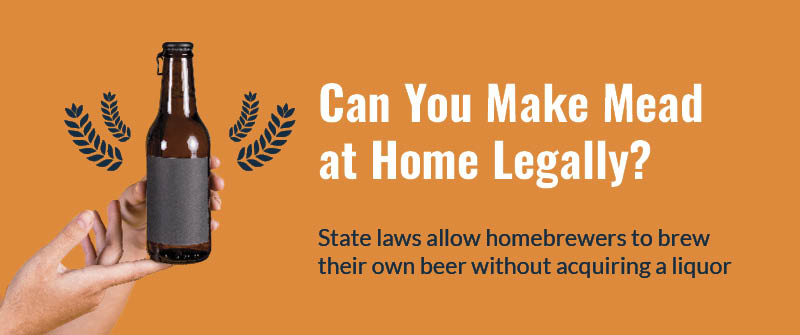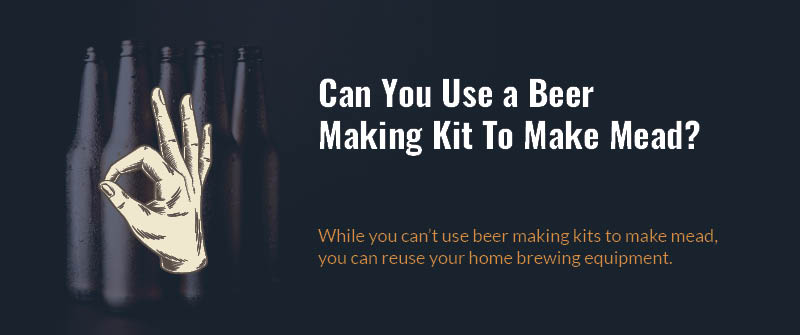Get off to the best start, with our homebrew starter kits! Our kits have everything you need to make your first batch of delicious homebrew. Get started in brewing your own beer with the best possible equipment on the market, backed by years of experience from our collective staff that are here to support you 7 days a week.
Billy Currington said it best when he sang: "God is great, beer is good, and people are crazy." While this song topped the charts in 2009, people have brewed beer since ancient times. In the United States, home brewing has grown as a hobby since its legalization in all 50 states in 2013. In 2017, the number of active homebrewers passed one million, according to the Library of Congress. As the hobby has grown, so too have the ways to engage with it. So whether you love craft beer, or are just looking to save money and find a new hobby, it's easier than ever to get started brewing your own beer at home. In this guide, we'll cover:
- The basics of brewing beer and mead at home
- What beer kits are and how beer recipe kits benefit home brewers
- Where to find beer-making supplies for cheap (or at least without breaking your budget)
Bottoms up!
Can You Make Mead at Home Legally? What About Brewing Beer?
Yes! At the time of writing, it is legal to make beer, wine, and mead in your own home in all 50 states, according to the National Conference of State Legislatures (NCSL). Producers of homemade alcoholic beverages must be of legal drinking age, and quantities are limited depending on the state and type of alcoholic beverage being produced.

State laws allow homebrewers to brew their own beer without acquiring a liquor license, reducing both the cost and hassle of getting started! There are a couple of exceptions to keep in mind, however:
- It is illegal to sell homemade alcoholic beverages without a liquor license.
- Consumption of homemade alcoholic beverages is typically restricted to the premises, but you can transport limited quantities to organized events like competitions.
Laws surrounding the at-home production of alcoholic beverages vary by state, so be sure to check the laws in your area for specifics. Now that we've covered the fine print, let's get into the fun of creating your beer and other beverages, as well as what you need to get started!
What Equipment Do I Need To Make My Own Beer?
To brew your own beer at home, you'll need the following pieces of equipment:
- Fermenter: This container is where your wort (mixture of water, malt, hops, and yeast) ferments into beer.
- Airlock: This is a one-way CO2 release during fermentation, so pressure doesn't build up and contaminants don't get in.
- Brew pot: Your pot will typically need to handle 2-3 gallons of water at a minimum (7.5 gallons preferred), and it will need to fit on your heat source.
- Heat source: In many cases, your kitchen stove will do. However, some people use other heat sources, including turkey fryers!
- Siphon: This equipment makes transferring liquid between large containers easier and less messy.
- Cleaning and sanitizing supplies: These supplies kill pesky contaminants that could ruin the taste of your batches.
- Hydrometer: Hydrometers help you monitor gravity, or sugar density, in your brew, which will impact the alcohol content.
- Bottling Container with Spigot (a.k.a. Bottle Filler): This container needs a spigot attached and will help you easily transfer your brew into bottles.
- Glass Bottles: After your beer is finished, you'll need to put it into something, and glass bottles are the perfect solution for beer storage.
- Bottle Caps: Your glass bottles will need to be sealed off with something!
- Bottle Capper: This tool will help seal the bottle caps onto your bottles.
In addition to this specialized equipment, you'll also use some of your kitchen tools. Stirring spoons, measuring cups, a strainer, a thermometer, and more can help you throughout the brewing process.
With your equipment ready, it's time to stock up on beer-making supplies. One way to get everything you need is with a home brewing kit. These kits contain all the hops and grains needed for a fresh batch of cold ones. However, many kits do not include yeast, so be sure to pick up this essential ingredient!
If you're on the lookout for beer-making supplies in the USA, then you've come to the right place. Great Fermentations is your one-stop shop for beer (and wine, mead, and cider) making equipment and supplies. Visit our online store to browse our collection of brewing supplies and hardware, wine ingredient kits, cleaning and sanitizing supplies, bottling equipment, and so much more.
Can You Make Good Beer from a Kit?
Yes--with the right kits, you can make great-tasting beers even without years of experience! This makes using beer kits an easy way to start the hobby. To see how simple it can be, here's how to brew beer with a beer making kit:

Brew Day
- Set up your space with the necessary equipment. You'll need a large brew pot, a heat source, a siphon, a fermenting bucket, an airlock, a hydrometer, a stirring spoon, a measuring cup, a strainer, a thermometer, and cleaning supplies.
- Gather your ingredients. This is where beer making kits come in handy. Rather than jumping from store to store trying to find that perfect combination of grains and hops, you can get them all in a single package! Take our Chico Suave Pale Ale Beer Kit, for example. This kit comes with 11 malts and hops, already portioned out for a five-gallon batch. Beer kits also come with instructions to help guide you through the process. While beer kits come with many useful ingredients, you'll also need some ingredients that aren't included. For example, you may need to provide your own yeast and priming sugar.
- Clean your equipment. To prep for sanitizing, you need to thoroughly clean your equipment first. During this step, you'll be removing gunk and residue from your equipment. Use cleaning supplies designed for home brewing for best results.
- Sanitize your equipment. Bacteria can ruin your brew, so it's critical that you sanitize all of your equipment--from your brew pot to your stirring spoon--to minimize the risk of your batch going bad. While standard cleaning chemicals can be effective, they may also impact the taste of your beer. Fortunately, there are sanitizing supplies specifically designed for home brewers.
- Boil your ingredients. The basic steps here are to steep your grains and add any malt extract, bring your brew to a boil, add your hops, then continue boiling for about an hour. For a detailed walkthrough, check out the instructions for our Chico Suave Pale Ale Beer Kit. This step is exciting because you may be able to sneak a taste during this step!
- Cool and ferment. Transfer your liquid concoction (called the wort at this stage) to your fermenting bucket. Next, add water until your wort is five gallons. Adding water (and some ice) also helps cool your wort, which needs to be below 80°F for the yeast to function properly. Once you've added yeast, you can seal the bucket with a lid and airlock. Fermentation periods and temperatures vary depending on your beer making kit. The Star Partner Thiolized West Coast IPA All Grain Beer Kit should ferment for two weeks at 64°F-72°F.
Bottling Day
- Clean your equipment (again!). To keep pesky contaminants out, you first need to remove the gunk they cling to. Ingredient residue, gunk, and even dust all need to go before each and every use.
- Sanitize your equipment (again!). Cleanliness is key every time you put your brewer's hat on. Your caps, tubes, bottles, and the rest of your equipment should be sanitized before use.
- Add priming sugar to the bottling container. This will help your beer carbonate properly.
- Transfer the beer to the bottling container. Use a siphon to transfer the beer into your bottling container, which should have a spigot attached.
- Fill bottles with beer. Use tubing to connect the spigot to each bottle, then fill 'em up! Spills are part of the process, so don't stress about any mess. Just keep a supply of paper towels handy.
- Cap and store bottles. Use a capper to seal each bottle. This tool is important to ensure a complete seal, which allows your beer to carbonate properly. Let your beer sit for two to three weeks before serving.
- Share your brew with friends and family! Beer is made for drinking, and who better to share it with than those closest to you? Using a beer making kit helps get the right mix of ingredients while following steps correctly, so you can be confident that tasters will enjoy each sip.
While the overall brewing process doesn't change much when using a beer making kit, doing so can help you save time during setup and ensure that you're using the right mix of ingredients.
Can You Use a Beer Making Kit To Make Mead?
While you can't use beer making kits to make mead, you can reuse your home brewing equipment. However, just like when brewing beer, it's critical to clean and sanitize your equipment before each and every use. It's also important to note that the process of making mead at home is different than making beer. Here's what the mead-making process looks like:
- Gather and sanitize equipment. Making mead uses the same equipment as brewing beer.
- Mix honey and water.
- Add yeast and desired nutrition, such as fruit. Mead takes different yeast than beer, which you can find in dry or sweet varieties.
- Seal the mixture in a container with an airlock to prevent contamination (and release pressure from CO2).
- Ferment the mixture for two weeks to a month. This will depend on which ingredients you're using and what temperature you're keeping the mixture at. When the mead stops bubbling, it's finished fermenting.
- Transfer the mead to a new container, and store it in a dark area for two more months.
- Bottle, cap, and let the mead sit for up to three months to let it age before consumption.
For more on how to make your own mead, browse our shop for resources.

Do Home Brewing Kits Work Well?
Home beer making kits work well for brewers who are new to the hobby and want to start off with great-tasting batches. These kits are also ideal for those who want to spend less time messing with different ingredients and portions. While beer making kits have a lot to offer when it comes to taste and convenience, they have less to offer in customization. Fortunately, there's a workaround to this limitation--try new flavors! Here's just a taste of the different kits we offer at Great Fermentations:
- Limerick Dry Stout Beer Kit
- Bonsai Dog Ale Beer Kit
- Martha's Hopyard East Coast SIPA Beer Kit
- Squash Gourdon Imperial Pumpkin Ale Beer Kit
- Hello There West Coast IPA Beer Kit
How Much Beer Does a Brew Kit Make?
Typically, beer making kits produce five gallons of beer, although some may be designed for different-sized batches. With a kit that makes five gallons of beer, you can fill 54 bottles of your own homebrewed brewskis.
How Long Does It Take To Brew Beer?
From start to finish, it typically takes two to four weeks to brew a batch of beer at home. That includes:
- Four to six hours on the brewing day
- One to two weeks for fermentation
- Couple hours on the bottling day
- Two to three weeks for the beer to carbonate after bottling
Each recipe is different, so be sure to check your beer kit instructions for exact fermentation times. For example, the Lunar Crushable Thiolized Light Lager Beer Kit requires 12 to 14 days of fermentation. However, if you're including a secondary fermentation process, then the first fermentation should be 6 to 8 days, and the secondary fermentation should be an additional 7 to 14 days.

Is Home Brewing an Expensive Hobby?
Home brewing costs vary widely depending on how much you want to invest in the hobby, but the good news is that it is affordable to get started with basic equipment. Think about it like fishing. You could buy a fishing pole, a hook, and some worms to catch bass at the local pond. Or, you could charter a deep-sea fishing boat to go after sharks. Either way, you're still fishing, but your costs and experience will be significantly different.
At-home brewing is similar. You can get started with relatively inexpensive and basic equipment and ingredients. As you gain more experience, you can invest in better equipment that saves you time and frustration and helps you brew tastier beer.
To get an idea of the upfront investment for making your own beer, browse our selection of homebrew starter kits. You'll also have ongoing costs, like ingredients and beer making kits.
Are Beer Brewing Kits Worth It?
Beer brewing kits are worth it for two reasons:
- They save you time picking out the right combination of ingredients.
- They help you make great-tasting beer without countless batches of trial and error.
With a beer brewing kit, you're paying for exactly what you need for that batch. This means you won't end up with awkward amounts of ingredients that you paid for but didn't use. Kits also produce quite a bit of beer. Five-gallon kits (like the Tha CommUNITY American Lager Beer Kit - Big Brew 2022) fill about 54 bottles!
Do Home Brew Kits Go Bad and, How Long Do Beer Recipe Kits Last?
The ingredients in homebrew kits do have expiration dates, which are different for each ingredient. On average, beer making kit ingredients last for:
- Milled Grains: 2 to 4 weeks
- Unmilled Grains: 1 year
- Dry Malt Extract: 1.5 years
- Liquid Malt Extract: 1 year
- Hops: 1 year
Yeast is typically sold separately from beer making kits, but this ingredient should also be used before its expiration date for the best results. The average shelf life for yeast is:
- Dry Yeast: 1 year
- Liquid Yeast: 3 to 6 months
Beer making kits come with the exact ingredients you need, so you should consider the shortest shelf life for your ingredients when planning when to brew.
What Is the Easiest Beer To Homebrew?
The easiest beers to homebrew have some or all of the following qualities:
- Easy-To-Follow Recipe: The fewer steps there are, the fewer the chances for errors. Beer making kits come with instructions, so you don't have to guess what to do while you brew.
- Relatively Short List of Ingredients: Like with cooking or baking, it's easier to brew when you have fewer ingredients to manage.
- Basic Flavor Profile: Complex flavor profiles require... you guessed it, complex recipes! Simple beers still taste great, so they're the perfect place to start.
- Requires Only One Fermentation Process: Some recipes require two fermentation processes, which extends the brewing process and adds extra steps.
In general, the easiest beers to brew are:
- American Amber Ale
- American Brown Ale
- America Pale Ale
- American Wheat Ales
- Porters
What Is the Easiest Beer Making Kit To Use?
The easiest beer making kits to use come with pre-measured ingredients and clear instructions. These benefits will save you time and ensure you have the right mix of hops and grains to make a tasty brew. Of course, the easiest beer making kits to use are also designed to brew the easiest beers to make (which you can find in the previous section). Here are some of the best beer making kits for beginners:
What Are the Best Beer Kits?
The best beer making kit for you is one that fits your tastes, experience level, and budget. For example, if you prefer a light, crisp taste, try out the Ich Bin Ein Pilsner Extract Kit. If you're looking for a beginner-friendly brew, go for Gayles Pale Ale Beer Kit. And if you want to start with a smaller batch, you can also explore one-gallon beer kits.
Finding the best beer kit for you will be a process of trial and error, so enjoy the process (and the beer)!
How Great Fermentations Beer Making Kits Can Help
Great Fermentations is your go-to resource for all things home brewing. Whether you need a beer recipe kit or a homebrew starter kit, we can help you out. With a passion born in 1995 and growing ever since we've got you covered when it comes to:
- Brewing supplies, kits, ingredients, and equipment
- Kegging equipment
- Winemaking supplies
- Hard cider and mead supplies
- Home bar supplies
If you're in the Indianapolis area, swing by to tap into our 45+ years of combined experience. To stock up on home brewing essentials no matter where you are, browse our online store and contact us with any questions. We're hoppy to help!








